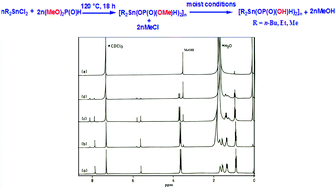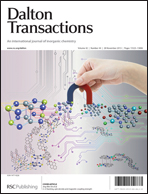Synthesis, characterization and selective de-esterification of diorganotinbis(O-methylphosphite)s†
Abstract
A one-pot reaction between di-n-butyl/diethyl/dimethyltin dichloride and dimethylphosphite (MeO)2P(O)H in a solvent free medium (120 °C, 18 h) proceeds smoothly to yield the corresponding diorganotinbis(O-methylphosphite)s, [R2Sn(OP(O)(OMe)H)2]n [R = n-Bu (1), Et (2), Me (3)]. The identity of 1–3 has been established by IR, multinuclear (1H, 13C, 31P, 119Sn) NMR, powder X-ray diffraction (PXRD) and X-ray crystallography. The coordination framework in each case adopts a one-dimensional structural motif comprising an infinite array of eight-membered [Sn–O–P–O]2 cyclic rings, with the phosphite ligands acting in a bridging bidentate mode. The structures are extended to two- (for 1) and three-dimensional (for 2, 3) assemblies by virtue of C–H⋯O hydrogen bonding interactions. The stability and bulk properties of 1–3 have been investigated upon exposure to humid laboratory conditions using 1H NMR, PXRD and SEM studies. The results conform to a unique chemical modification of 1–3 involving selective de-esterification of P–OMe bonds and the formation of corresponding diorganotinbis(phosphite)s, [R2Sn(OP(O)(OH)H)2]n (1a–3a), as insoluble solids. The results obtained from impedance studies (σ = 10−4–10−6 S cm−1; Ea = 0.33–0.42 eV) reveal potential application of 1a–3a as proton conducting materials.


 Please wait while we load your content...
Please wait while we load your content...